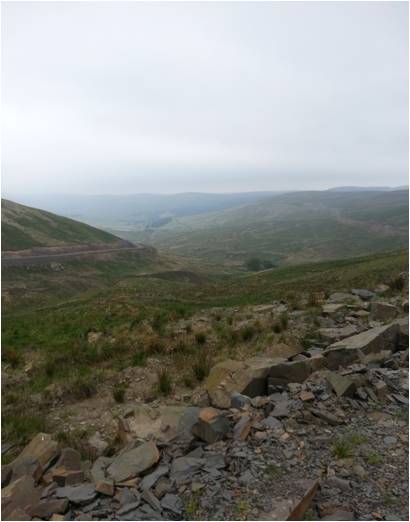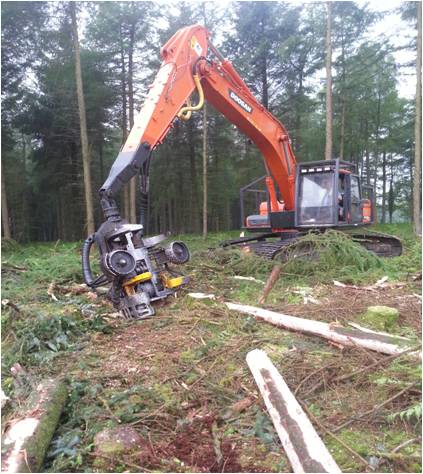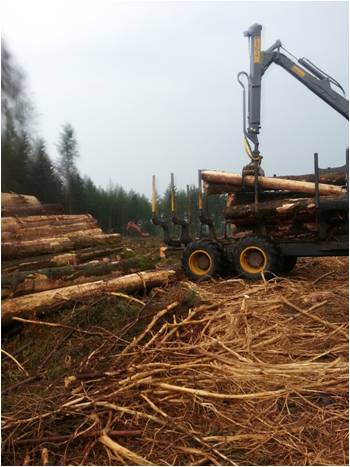Hannah Mansell, BWF Technical Liaison Manager
This year's PEFC stakeholder field trip aimed at engaging those attending with the process of growing and harvesting timber in the UK . As well as BWF, there was representation from paper manufacturers and printers, housebuilders, retail, construction and associated government organisations.
The trip began with an introduction to forestry and responsible management of UK timber. To demonstrate how land is procured and developed for the management of forests we visited ShepherdCleuch, a forestry plantation that is has only been growing trees for 2 years.
 ShepherdCleuch is a 2 year Sitka Spruce plantation created after the purchase of two sheep farms and managed on behalf of the owner by Scottish Woodlands.
ShepherdCleuch is a 2 year Sitka Spruce plantation created after the purchase of two sheep farms and managed on behalf of the owner by Scottish Woodlands.
What was interesting about this site is it was true demonstration of contemporary forestry management techniques. The land has been procured and developed from relatively low economic return sheep farming land to a cash rich crop of Sitka spruce forest. However, before the planting of trees started there was much work to ensure that the land was optimised for timber harvesting without negatively impacting the environment.
Initially the land was surveyed to understand quality of soil and to ring-fence special areas of environmental habitat requiring protection. This developed into the identification and plotting out of where the crop of Sitka would thrive and areas that should be left for the planting of Broadleaf trees such as Larch, Willow, Oak, Rowan and Alder, developing the natural long term landscape of the future.
Looking across the dramatic view of the different forests surrounding Lockerbie we can see not only plantations of different ages, but the change in forestry techniques is also evident. 30-40 years ago, the landscape was block filled with spruce, with little consideration given to encouraging environmental diversity or protecting the land for the future. In essence, little regard was given to the long term future of the landscape. Now, as we look towards to more recently planted forest, visually they look different, the shape and colour of the tree planting is broken up with tracts of land that have been left for nature to flourish without human interference. In addition, there have been changes to forestry techniques that are not visually evident. The prohibition of many weed control chemicals and methods used to clear land for plantation has changed to have as little impact of the land and the existing ecosystem as possible.
The afternoon presented a visit to one of the James Jones estates where we watched a thirty year old forest being harvested. James Jones works closely with their small teams of sub-contracting loggers. Many of these teams are family run businesses, who have worked for generations with James Jones. It was interesting to note the close relationship that has formed over the years between the land owner and the loggers. The logging teams have in depth knowledge of the land and the trees and are highly skilled in selecting the timber at the point of chopping it down.
 The logging teams work from dawn till dusk and consider every single tree individually to sort them by size and species to optimise them for usable timber. The sorting process starts here in the forest. Using specialised plant equipment, each tree is secured and chopped at its base and then automatically run through the cutting head (see photo) and chopped at the optimum length.
The logging teams work from dawn till dusk and consider every single tree individually to sort them by size and species to optimise them for usable timber. The sorting process starts here in the forest. Using specialised plant equipment, each tree is secured and chopped at its base and then automatically run through the cutting head (see photo) and chopped at the optimum length.
The logs are then picked up and sorted into piles dependant on size and what product the timber is to be used for. The top of the tress, the narrowest part, will not provide any real usable dimension of timber to be machined into plank form and is sorted at this stage and diverted toward the production of timber pulp for the paper and composting industry.
 The insight into the relationship between the loggers, the forest owner and the environment demonstrated a delicate but well-practiced routine. The methods involved in clearing forests in a safe and efficient manner was directly attributed to the skill and the knowledge of the logging teams.
The insight into the relationship between the loggers, the forest owner and the environment demonstrated a delicate but well-practiced routine. The methods involved in clearing forests in a safe and efficient manner was directly attributed to the skill and the knowledge of the logging teams.
The next day we travelled to the James Jones Sawmill where the trees that we had seen being harvested the previous day had been shipped to overnight. Lockerbie is a quiet agricultural town and the short morning rush hour is broken by the constant rumble of trucks transporting logs to feed the sawmill. Upon entering the site, the sheer scale of the production facilities become evident. Almost as far as the eye can see, there are piles of logs awaiting processing.
The trees move through the process, initially having their bark and stumps removed, in preparation for processing through the sawmill. When the logs enter the machining process, every single piece is x-rayed and any defects are identified to be removed in the cutting process. At this point the logs are not of consistent dimension and as they are scanned, the pre-programmed software optimises the different cuts and raw timber sizes from each log. This minimises waste and ensures that production is in line with the current order book.
Some of the key points I took home from the PEFC field trip related to the following.
Traceability – The product is traced from forest to customer. Systems are operated to ensure that there is ultimate traceability of every component that enters the production chain.
Technology – Advances in forestry, logging and saw milling technologies have increased efficiency of production and optimisation of material.
Environmental protection for the long term future – By using certified and traceable product, UK manufactures are ensuring that their material is sourced responsibly.
Sustainable future – The strict policy of replanting and rotating the crop of timber contributes to both the economic and environmental sustainability of the area.
Knowledge of product and process – The individuals involved at every stage of the process are highly knowledgeable about material and process. The entire workforce is educated into thinking about how they can improve the process and this is integral to successfully managing this enterprise from both an environmental and commercial perspective.
Lean manufacturing – From the forest to the sawmill, the production process is keyed towards lean methodology. Waste and material movement is kept to a minimum and the entire workforce is involved in operating in the most efficient manner possible.
Tight systems of quality control – This ensures that all product conforms to the relevant standards particular to the end product. A strict regime of testing and auditing ensures that product is fit for purpose.
For further information about using certified timber and ensuring that you have the right safeguards in place in your business contact Hannah.Mansell@bwf.org.uk
Companies who need FSC and PEFC Chain of Custody Certification are reminded that they can get this through the BWF's Joinery Toolkit with reduced rates for BWF members. If you have 15 or less employees (or less than 50 if you want PEFC certification), then you may be eligible to join the BWF Group Chain of Custody Scheme.